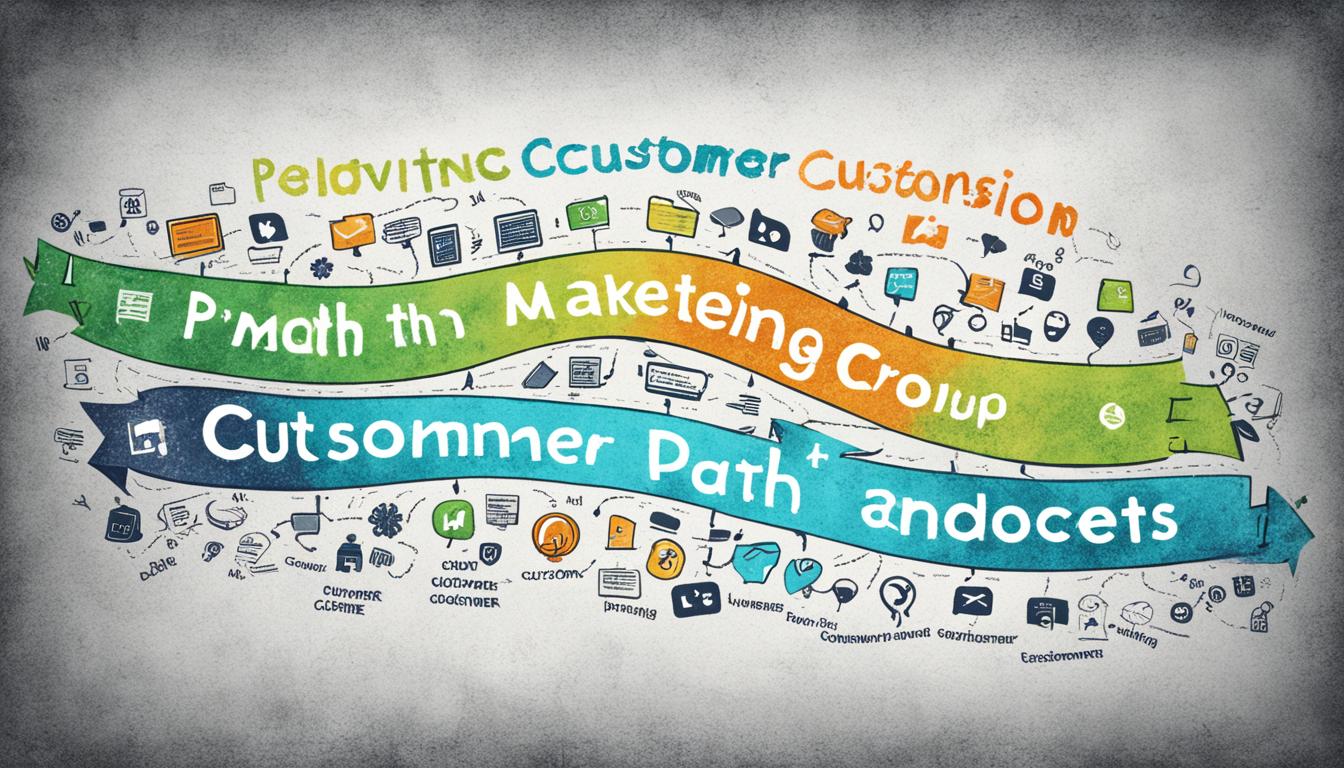Welcome to our guide on revenue marketing! Businesses today need good marketing strategies more than ever. This is because they want to get more leads, get more customers, and grow their sales. Revenue marketing helps by matching marketing plans with business goals. It makes sure you get the most out of your investment.
It also uses smart analytics to focus on campaigns that make money.
So, what’s revenue marketing all about? We’ll look into what it means, its main parts, and how it helps businesses. You’ll learn how to create a strong revenue marketing strategy. This includes working closely with sales, making effective marketing materials, understanding your customers’ journey, using technology wisely, and keeping track of progress with metrics and KPIs.
By looking at real-world examples, you’ll understand revenue marketing better. You’ll see how it can change your marketing into a major source of income.
Key Takeaways:
- Revenue marketing aligns marketing plans with revenue goals, focusing on lead generation and sales growth.
- It maximizes ROI and optimizes marketing analytics to drive targeted campaigns.
- Revenue marketing enhances customer acquisition, team alignment, and goal-setting.
- The key components of revenue marketing include acquiring customer data, aligning stakeholders, defining processes, implementing technology, and managing results.
- An effective revenue marketing strategy involves setting SMART revenue goals, conducting website and marketing ROI audits, conducting research for actionable steps, and implementing lead generation plans.
What is Revenue Marketing?
Revenue marketing is about using different ways to create campaigns that help get more customers and boost sales. It works by bringing in new customers through smart marketing linked to revenue goals. With targeted campaigns, companies can find leads and get new customers, which increases sales and revenue.
Key Elements of Revenue Marketing
There are several important parts that make revenue marketing work well:
- Marketing Campaigns: It’s about making targeted campaigns to find leads and get more customers. These campaigns aim to meet revenue goals and help sales grow.
- Lead Generation: A major goal of revenue marketing is finding good leads more likely to become customers. Strategies to draw and engage potential customers are key.
- Customer Acquisition: This approach tries to gain new customers with focused marketing. Using personalized messages, targeted ads, and ways to effectively turn leads into customers are part of the strategy.
- Sales Growth: By matching marketing with revenue goals, revenue marketing seeks to increase sales. Success comes from using data wisely, focusing on customers, and continuously improving marketing actions.
Using revenue marketing strategies can greatly help a business’s profits by increasing revenue growth and boosting business performance. By planning and carrying out marketing campaigns focused on making money, businesses can grow steadily and stay ahead in the fast-changing market today.
Benefits of Revenue Marketing
Revenue marketing is way better than old school marketing. It cares about making money, not just getting noticed. Here’s what makes it great:
Increased Customer Focus
Revenue marketing gets what customers want. By using data smartly, companies send the right messages. This grabs attention and keeps customers coming back for more.
Enhanced Team Alignment
Marketing and sales teams work hand in hand in revenue marketing. They chase the same money goals. This teamwork helps turn leads into sales more smoothly.
Improved Goal-Setting
Revenue marketing makes planning goals easier. It’s all about the money. So, companies know exactly where they want to go and how to measure success.
Table: Comparing Revenue Marketing and Traditional Marketing Approaches
| Revenue Marketing | Traditional Marketing | |
|---|---|---|
| Focus | Increased Customer Focus | Broader Audience Reach |
| Goal-Setting | Revenue Metrics | Brand Awareness, Impression |
| Team Alignment | Marketing and Sales Collaboration | Separate Siloed Departments |
| Lead Generation | Targeted, Data-Driven Approach | Generic, Mass Marketing |
| Measurement | Revenue-Based Metrics | Vanity Metrics (e.g., Impressions, Likes) |
Revenue marketing gets businesses ahead. It turns marketing into real earnings. Customers, teamwork, and smart goals are why it works so well.
Key Components of Revenue Marketing Efforts
Revenue marketing needs a full strategy that includes many parts. By using these parts well, companies can make their marketing better. This helps them earn more money and succeed in the long run.
1. Customer Data Acquisition
Getting the right customer data is key for revenue marketing. Understanding customers lets businesses create marketing that fits. They use surveys, check website data, and follow social media to learn about customers.
2. Stakeholder Alignment
It’s important for marketing, sales, and leadership to work together. This teamwork helps everyone aim for the same goals. It makes sure work flows well and increases the effect of marketing efforts.
3. Process Definition
Having clear processes helps with marketing strategies. Companies need to have set steps for marketing and sales. This makes work more efficient and leads to steady results.
4. Technology Implementation
Using tech is very important in revenue marketing. Tools like automation, CRMs, and analytics help companies. They make tasks easier, improve interactions with customers, and help understand data.
5. Results Management
Managing results well is crucial. With good analytics, companies can see how their marketing does. They check things like how many customers they get and how much campaigns cost. This helps companies make better choices to improve.
| Component | Description |
|---|---|
| Customer Data Acquisition | Collecting relevant customer data to inform targeted marketing campaigns |
| Stakeholder Alignment | Aligning marketing, sales, and leadership teams towards revenue goals |
| Process Definition | Establishing clear processes to streamline marketing activities and maximize efficiency |
| Technology Implementation | Leveraging technology to automate tasks, track customer interactions, and gain insights |
| Results Management | Measuring and analyzing performance to optimize revenue marketing efforts |
By focusing on these key components, businesses can boost customer engagement. This leads to more revenue and long-term success.
Developing an Effective Revenue Marketing Strategy
To build a winning revenue marketing strategy, follow a clear plan with key steps. Include SMART goals, audit your website and marketing ROI, research deeply, and take steps based on data. This way, you can better your lead generation and grow your revenue.
Setting SMART Revenue Goals
Start by setting SMART goals for your revenue. SMART means Specific, Measurable, Achievable, Relevant, and Time-bound. With clear, measurable goals that you can achieve on time, you can truly focus. This helps in achieving real results.
Auditing Your Website and Marketing ROI
Checking your website and marketing ROI is key. It helps find ways to improve your revenue marketing strategy. Look at how your website performs, check your SEO, and see how well your marketing works. Doing so lets you make smart choices and use your resources well.
Conducting Research for Actionable Steps
Good research is essential for a solid revenue marketing strategy. Look at market trends, how customers behave, and what the competition does. This info helps you make good steps forward. You might refine your audience profiles or find new markets and channels.
Generating Lead Generation Plans
Lead generation is super important in revenue marketing. Use what you learned from research to make strong lead generation plans. These plans should match your SMART goals. You might use content marketing, social media, emails, or ads to pull in customers.
By taking these steps in your revenue marketing strategy, you craft a comprehensive plan. It helps in getting more leads, improving marketing ROI, and increasing your revenue.
Define the roles of your sales and marketing teams when it comes to growth
When you start with a revenue marketing strategy, it’s key to set clear roles for sales and marketing teams. Both groups are important in working together to hit revenue goals. To do this well, keep these steps in mind:
- Establish a Growth Strategy: Work together with your sales and marketing crews to make a growth plan. This plan should match your revenue goals. Pick out who you want to reach, how you’ll measure success, and what your income aims are.
- Create a Communication Plan: Make a plan to keep sales and marketing talking and working smoothly together. Schedule regular catch-ups, share calendars, and use quick chat tools. This will keep everyone on the same page and working well together.
- Align Resources: Put the right money, people, and tech in place to back your revenue marketing. You might need to mix sales and marketing tools, use CRM systems, and offer training. These steps will support your plans.
By making sales and marketing roles clear and boosting teamwork, companies can drive growth. This is all through smart revenue marketing plans.
Align resources to create proper collateral and campaigns
To succeed in revenue marketing campaigns, aligning resources right is key. This means making collateral and campaigns that meet goals. It involves SEO optimization, creating compelling content, and using email marketing effectively.
Create engaging content with SEO optimization
Key to revenue marketing is making content that both appeals to people and meets SEO standards. By finding the right keywords and using them in content, companies can rank higher in searches. Making meta tags, headings, and alt attributes SEO-friendly helps too.
Leverage email marketing to nurture leads
Email marketing is a must for driving sales and nurturing leads. By sending personalized emails, companies can reach out to customers at various stages. This includes everything from welcome emails to reminders and special offers.
| Stage | Objective | Content |
|---|---|---|
| Awareness | Introduce the brand and create interest | Newsletter subscriptions, educational content |
| Nurture | Build trust and engage with leads | Drip campaigns, personalized content |
| Conversion | Encourage leads to make a purchase | Promotions, special offers, limited-time deals |
| Retention | Retain customers and drive repeat purchases | Loyalty programs, exclusive content |
Develop compelling collateral for targeted campaigns
Good collateral is central to successful campaigns. It includes e-books, whitepapers, and more, designed to meet audience needs. Clear CTAs in the collateral guide the audience on what to do next.
It’s vital to align resources like SEO, content making, and email strategies for revenue. By doing this well, companies can enhance their campaign results. This approach leads to long-lasting success in the market.
Map out the entire customer journey
Understanding the customer journey is key in revenue marketing. It lets companies make smooth and personal connections at each step of the way. This improves the whole customer experience.
Knowing the customer journey well shows businesses where they can make more money. It helps from the start to the final buying step. This knowledge directs marketing tactics and boosts how well they engage customers.
When laying out the customer journey, it’s crucial to think about many things. These include the ways customers get in touch, what they read, and where they decide things. Knowing this helps companies sharpen their marketing and make strategies that fit what customers do and like.
Understanding Touchpoints
Touchpoints are key interaction moments between customers and a brand. They range from website visits to social media, reading reviews, and talking to support. Each moment is a chance to make an impact and sway decisions.
Looking into touchpoints helps companies do better in making money. By knowing which points matter most, they can spend wisely and adjust their messages. This helps grow revenue.
Nowadays, touchpoints happen on various gadgets and platforms, like websites, social media, emails, and apps. Using tools to track and understand customer actions gives businesses great insights. This helps them make plans that really speak to their audience.
By laying out the full customer journey and knowing the key touchpoints, companies can offer personalized experiences that help them earn more. This deep insight guides businesses to better their marketing strategies. It boosts customer involvement and, in the end, raises sales and conversions.
Optimize your technology to help drive or measure revenue
To make more money, you need the right tech tools. This means using sales software, marketing tricks, and data to see how well your ads are doing. It helps you know what works and what doesn’t for making more sales.
Sales software is key for making more money. It makes selling smoother, helps keep track of leads, and boosts sales. It’s about knowing your customers better, keeping sales on track, and sealing deals faster.
Marketing tools are huge for making money, too. They let marketers set up tasks to run on their own, customize customer experiences, and send out big campaigns. Automating stuff like lead following, emails, and social media lets businesses push their marketing further. Plus, it makes getting new customers and leads better.
Data is super important for making your marketing better. With data tools, you can see how customers act, how well campaigns do, and where your money is really coming from. This info helps marketers make smart choices, tweak ads, and spend money wisely to bring in more revenue.
To wrap up, using tech the right way is huge for revenue marketing success. By setting up sales software, using marketing tools, and diving into data, companies can get better at what they do. This leads to more targeted campaigns, smarter spending, and, most importantly, more money.
Create metrics and KPIs to follow
It’s key to set up metrics and KPIs to track revenue marketing success. These measures help you see how well your marketing works and where to make it better.
For effective revenue marketing measurement, pick metrics that match your goals. You could track things like:
- Revenue Generated: Keep an eye on total revenue from marketing to see if your strategy works.
- Lead Conversion Rate: Check the ratio of leads turning into customers to gauge lead generation success.
- Customer Acquisition Cost (CAC): Figure out how much it costs to get a new customer. This shows if your marketing is cost-effective.
- Return on Investment (ROI): Look at the money made from marketing versus what you spent.
Setting KPIs also means setting clear goals for your revenue marketing. Make sure these goals are SMART. Some KPI examples are:
- Percentage Increase in Revenue: Aim for a specific growth in revenue to judge your marketing’s success.
- Lead-to-Customer Conversion Rate: Work to turn more leads into customers for more revenue.
- Marketing-Qualified Leads (MQLs): Have a goal for the amount of good leads marketing brings in.
To keep up with these metrics and KPIs, businesses can use dashboards. Dashboards show your data live, making it easy to see what’s working and what’s not.
By watching these metrics and KPIs, companies can understand their marketing better. This lets them tweak their strategy for more revenue.
Conclusion
Revenue marketing is a powerful way to grow a business, focusing on making money and expanding. It involves putting the customer first and ensuring sales and marketing work as one. This approach leads to lasting growth.
Putting customers at the heart of marketing is key. It’s about knowing what they want and making sure they’re happy every step of the way. This not only makes customers stick around but also encourages them to keep buying, boosting revenue.
It’s important to keep track of certain metrics in revenue marketing. These include how well leads turn into customers, the cost of getting new customers, and how much they spend over time. These measures help businesses know if their marketing is working and where to improve.
Having sales and marketing teams move in the same direction is crucial. This teamwork smooths the process of passing leads, enhances working together, and boosts the money made. When these teams share a goal of increasing revenue, the company can grow significantly.








